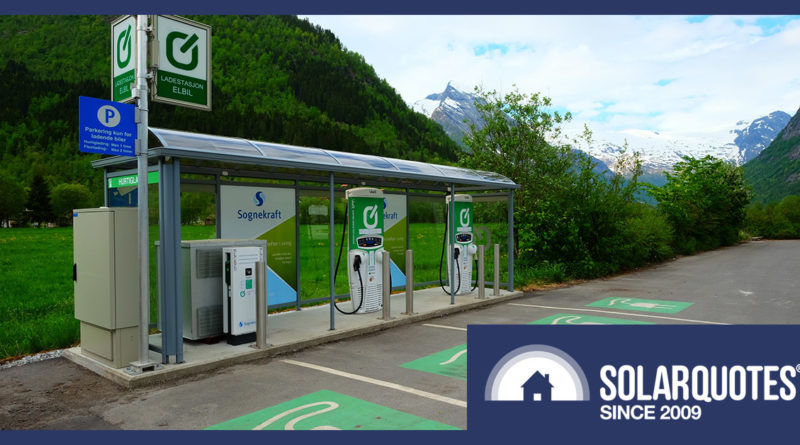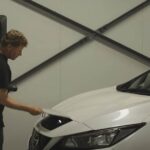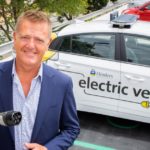Norway Has So Many EVs Their Battery Capacity Averages 13 kWh Per Household
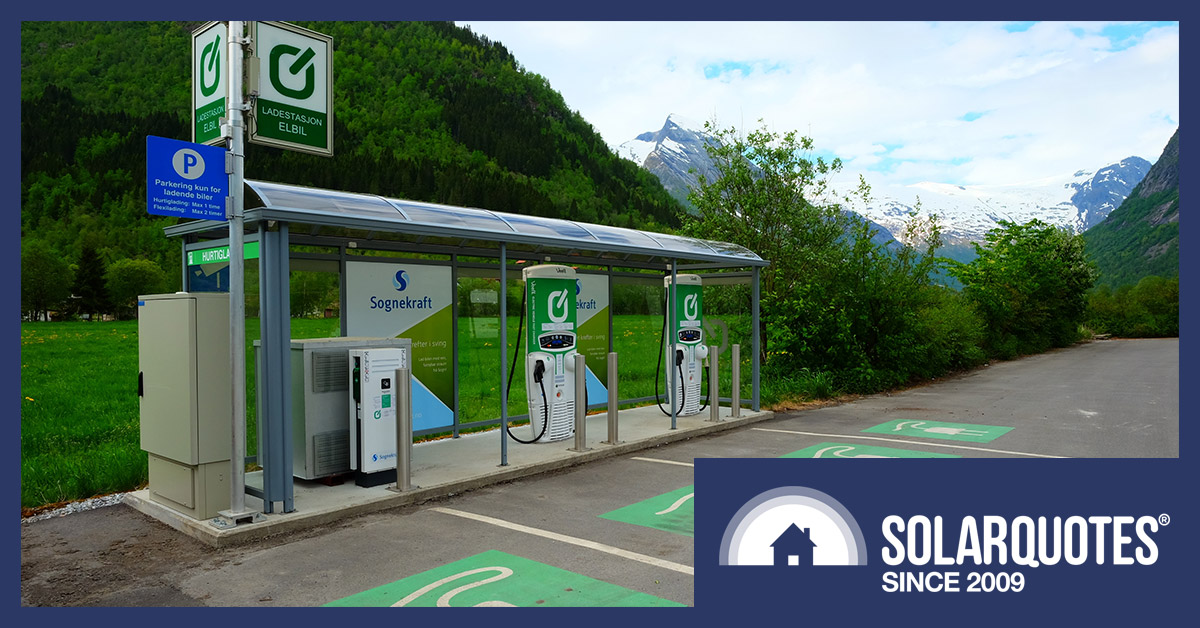

Norway has more electric cars per capita than any other nation. They have over half a million EVs, one for every 11 people. The combined capacity of all those rolling batteries is a whopping 34 gigawatt-hours.
That’s an average of 6 kilowatt-hours of storage per Norwegian, or 13 kilowatt-hours per household — a Tesla Powerwall worth of storage for every home. If they keep adding EV battery capacity at this rate, once road transport is 100% electric each household will average around 88 kilowatt-hours of energy storage on wheels.
Australia is following in Norway’s footsteps — or tyre tracks — and is starting to buy large numbers of electric vehicles. To help get us off fossil fuels, the Government should encourage EV purchases as a priority.
Ideally, any Australian EV incentives will favour cars that can provide grid-support via Vehicle to Home (V2H) and Vehicle to Grid (V2G) services. But even if EVs only ever act as a load, they will still be useful for grid management by storing surplus renewable energy generation.
Full EVs: 86% Of New Vehicles
In 2021 64.5% of new Norwegian car registrations were full EVs. For the first 3 months of this year, it was 82.9%. When plug-in hybrids are included, it rises to 91.1%. Conventional petrol and diesel vehicles were only 6.2% of registrations. The table below shows vehicles registered in 2022’s first quarter. I added translation notes from Norwegian in red:
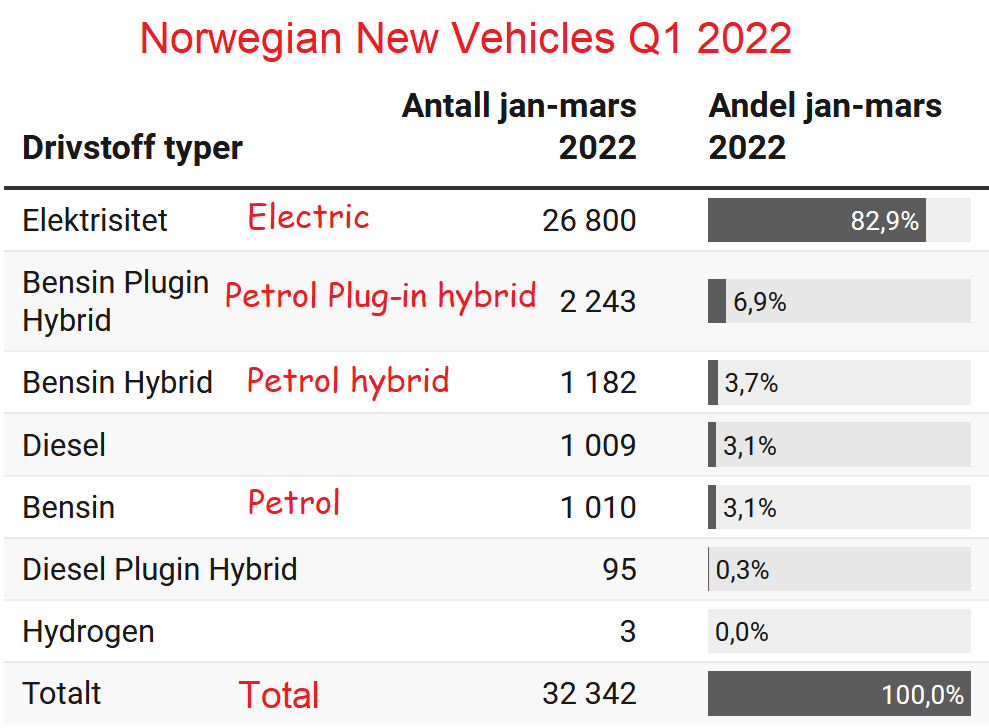
Damn Norwegians! I can forgive them for using words such as “Antall” for number and “Andel” for percentage, but using a comma instead of a decimal place is the devil’s work.
There are around 3.4 million road vehicles in Norway with 4 or more wheels. With over 500,000 full EVs, this means 15% are all-electric.
Hydrogen Cars Are No Go
Below I’ve shown how many hydrogen cars were sold in the first quarter compared to battery electric vehicles:


Battery electric vehicles outsold hydrogen vehicles by 8,933 to 1. Hydrogen cars are not taking off, and never will. Some people think hydrogen will be useful for heavy road transport, but I’m confident lower running costs will result in heavy trucks being battery electric.
Best Selling EV Models
Tesla produces the best selling EVs in Norway. The table below shows the top 10 best sellers in March this year:
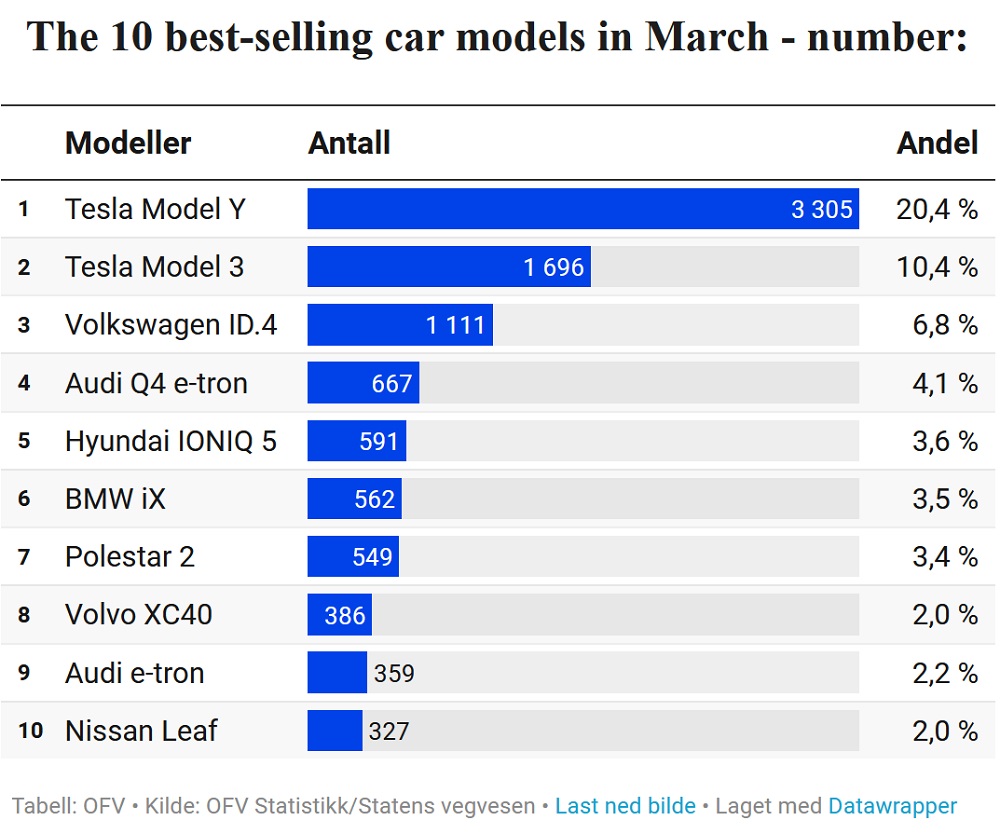
This information is taken from the Norwegian site called OF. This link should take you to a translated page.
Average Battery Pack Capacity
If I take battery pack sizes from the European EV Database and put them in the list of top 10 Norwegian EVs for March, I get the following:
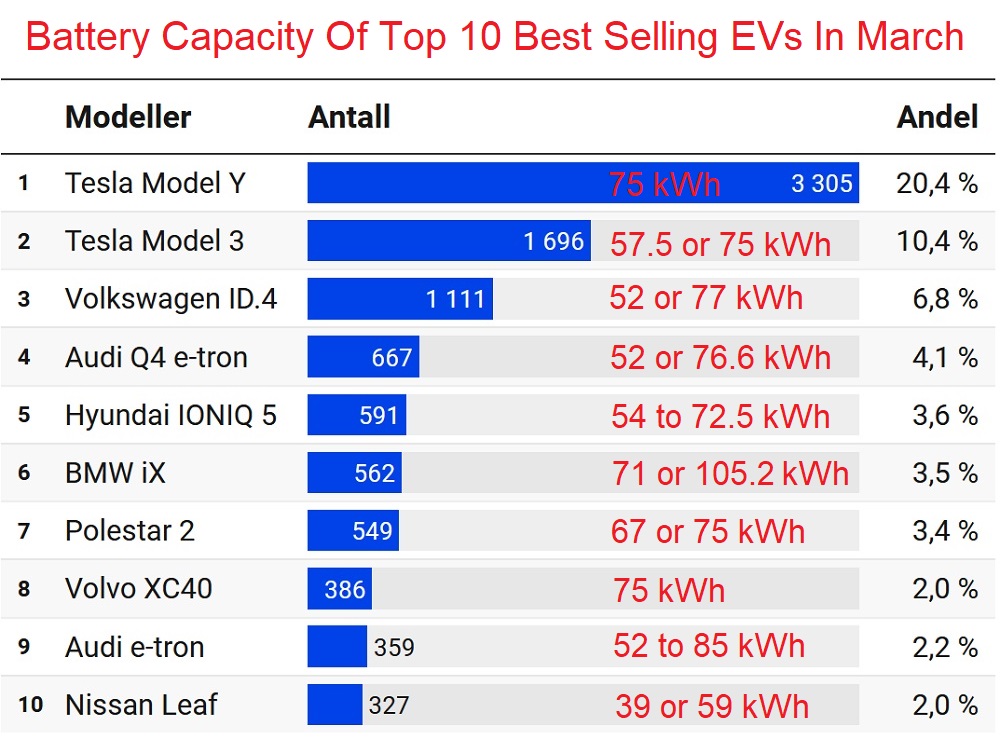

This makes it clear Norwegians like to buy EVs with large battery packs1. If I assume for EV models with more than one battery pack size that two-thirds have the smallest while the rest have the largest, I get the following figures:
- Total battery capacity of top 10 electric vehicles sold in March = 648,000 kilowatt-hours
- Average new EV battery pack size in March = 68 kilowatt-hours
Once the battery packs of the few EVs outside the top 10 are added, it comes to more than 650,000 kilowatt-hours. Acquiring that much battery storage on wheels in a single month is an impressive achievement for a country with only 5.5 million people. It comes to 0.25 kilowatt-hours per Norwegian household. Note these aren’t Australian sized households with an average of 2.6 people. Norwegians, quite understandably, can’t stand each other, so their average household size is only 2.1 people.
If Norwegians continue at this rate, over 12 months they will add another 3 kilowatt-hours of EV battery storage per household.
On top of this, Norwegians are also getting a teeny bit of additional battery storage inside plug-in hybrids. I expect plug-in hybrid sales have peaked and before long new car sales will be almost 100% EV.
Total Battery Storage On ‘Wegian Wheels
If we assume the average Norwegian EV battery pack size is 68 kilowatt-hours and ignore the smaller ones in plug-in hybrids, then Norway has around 34,000,000 million kilowatt-hours of battery storage on wheels. That’s 34 gigawatt-hours. Averaged out, it comes to…
- 6.2 kilowatt-hours per Norwegian.
- 13 kilowatt-hours per household.
Assuming battery pack capacity continues to average 68 kilowatt-hours, once Norway goes from their current 15% EV penetration to 100%, their battery storage on wheels will be…
- 42 kilowatt-hours per person
- 88 kilowatt-hours per household.
To provide some comparison, a Tesla Powerwall 2 home battery system has 13.5 kilowatt-hours of usable battery storage when new.
EVs & Norwegian Grid Management
Norway doesn’t have a problem integrating new renewable generation into its grid because it is almost entirely renewable already. It appears to be 88% hydroelectric and 10% wind:
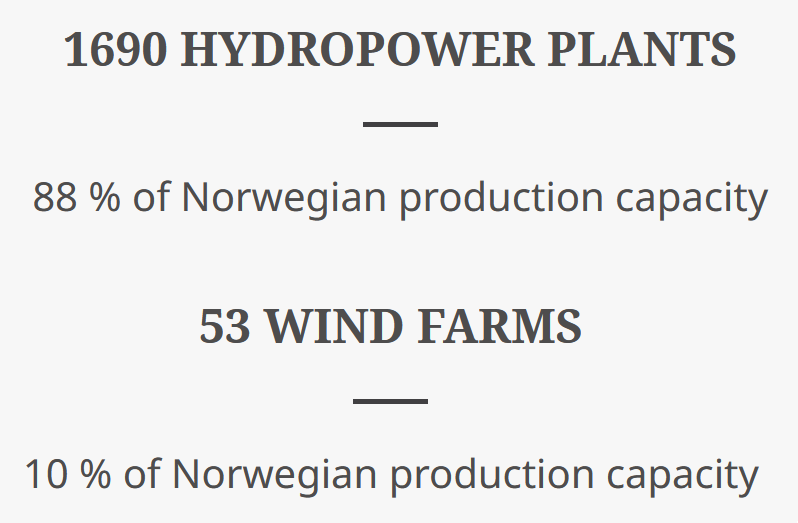
I tried to check whether “production capacity” meant production or capacity. My Norwegian is extremely limited, but as far as I can tell, the answer is “yes”.
Their massive number of hydroelectric dams can store enough energy to power their grid for over 8 months:
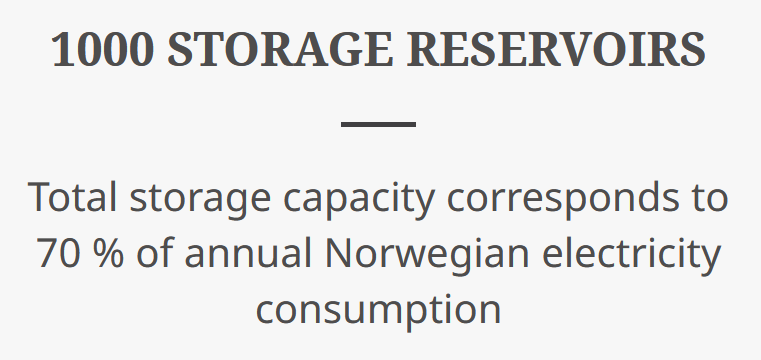

While Norway’s grid is almost as clean and green as it can get without sucking CO2 out of the air, almost every other country has a dirtier grid. Replacing internal combustion engine vehicles with EVs will make it easier for these nations to reduce fossil fuel generation.
Australian EVs & Grid Management
There are more than 20 million road vehicles in Australia with 4 or more wheels. If Australia had Norway’s 500,000 electric vehicles, that would only be 2.5% of the total. But even that would be useful for grid management. If you’re an EV owner, it’s plainly to your advantage to charge when it’s cheap, generally when all the solar is generating. You can use your own solar power system, or you can take advantage of everyone else’s solar panels by choosing an electricity plan with dirt-cheap daytime rates. There’s also no reason you can’t take advantage of both.
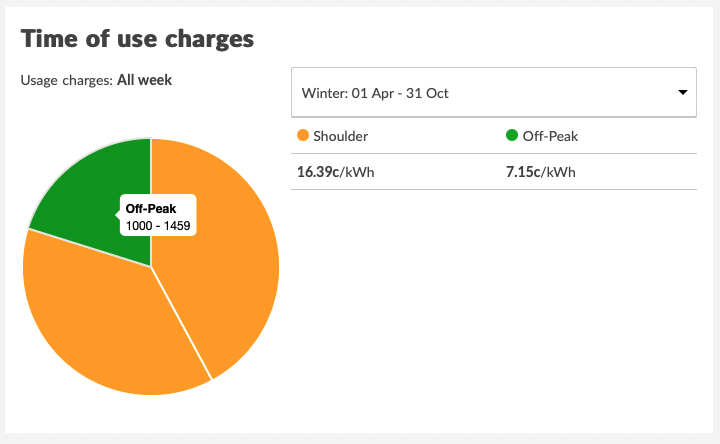
ReAmped’s Advance Time of Use Plus tariff in SA offers daytime electricity for just 7.15 cents per kWh
EVs will make wind and solar energy generation more profitable by increasing grid demand when renewable output is high. This will result in more new renewables driving fossil fuels out of the market2.
If half a million EVs were all plugged into 7kW car chargers, it would be technically possible to draw up to 3.5 gigawatts of power from the grid. That’s more than Australia’s largest power station can generate.
Obviously, people aren’t going to keep their electric vehicles plugged in all the time. They’ll want to drive them at some point. But they’ll prefer to charge them when it’s cheap.
V2G
Instead of just drawing power from the grid, electric vehicles can also push power back in one of 2 modes:
- V2H — Vehicle 2 Home: Your EV powers your home but does not export to the wider grid.
- V2G — Vehicle 2 Grid: Your EV exports power to the grid for anyone on the local grid to use.
Both of these are only being trialled in Australia3, but they have huge potential.
When Australia’s EV stock reaches 15% of all vehicles, like Norway has today, we’ll have 3 million electric vehicles on the road. If connected to bi-directional 7kW chargers, they could push up to 21 gigawatts into the grid. That’s enough to supply 2 kilowatts to every home in Australia and is more than the combined mid-afternoon power consumption of Queensland and NSW during a heatwave. Doubling the number of cars would let them supply more instantaneous power than the country has ever used.
Electric vehicles won’t have to provide power for long periods to be useful. Even if they only support the grid for a dozen hours a year, it would be enough to help prevent blackouts and provide grid stability. It will also result in very little battery deterioration because 7 kilowatts is nothing compared to the 200+ kilowatts the battery might have to punch out when you put your foot down driving up a hill.
Norway Is The Way
Which way should Australia go when it comes to EVs? I say Norway is the way. The advantages to our health, the environment, and the grid, are too huge to pass by. Fortunately, EVs have improved in quality and fallen in price, so we won’t have to offer the same level of incentives as Norway to transition to electric wheels.
A major reason electric vehicles have improved in price is due to demand from Norway, and there’s no way I’d let that pass without expressing my appreciation, so thank you Norway. We wondered who would be the first to electrify road transport? It turned out a Norwegian would.
[embedded content]
Footnotes
- I like big batteries and cannot lie, You other ‘Wegians can’t deny, EV rolls in ready to race, Big battery pack in yo face…
- Coal power stations can also benefit from EVs charging when prices are low but are hurt more by the increased renewable capacity.
- But note there are EVs that will let you plug in an extension cord and run appliances off the battery pack. A feature that can be extremely handy in a blackout.
Original Source: https://www.solarquotes.com.au/blog/norway-ev-batteries/




